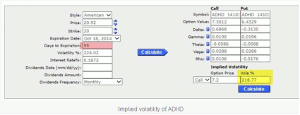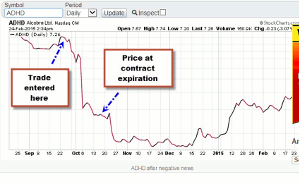Alan Ellman, of TheBlueCollarInvestor.com, highlights the importance of Vega—the amount an option price will change for every 1% change in volatility—and cites an example to illustrate how crucial it is for option traders to comprehend the rationale behind both sides of a trade.
Understanding the Greeks—or factors that impact the value of our covered call premiums—is essential to mastering options trading basics and becoming an elite covered call writer. One of the Greeks (although not truly a Greek letter) is Vega, the amount an option price will change for every 1% change in volatility. As the anticipated or implied (implied by the option premiums) volatility of the underlying security moves higher, so does the value of the option premium if all other factors remain the same. This implied volatility is different from the historical or statistical volatility which is based on actual price fluctuation over a specific time frame.
This understanding of the impact volatility has on our option profits has led some investors to look for divergences between historical and implied volatility, specifically when implied is well above its historical statistics. The theory here is that the greater the divergence, the greater the opportunity to generate higher returns. Here is an example of such a trade made a few months ago by a friend of one of our members, Tony:
The company is Alcobra (ADHD), a pharmaceutical company known for dealing with attention deficit medical conditions.
- Buy ADHD @ $20.92
- Sell October17, 2014 $20 call @ $7.20
Let’s feed this information into the multiple tab of the Ellman Calculator:
The results show a huge return of 31.4% in less than two months and also downside protection of that profit of 4.4%. In other words, share value can drop by 4.4% by expiration and we still would have generated a return of 31.4%. Equally as impressive is the trade breakeven point of $13.72. Can this be the free lunch we all have been searching for?
So why are option buyers willing to pay us such a generous premium? It is so important to understand the other side of a trade in addition to looking at it from our perspective. The answer goes back to implied volatility or the market’s anticipation of future price movement of the underlying security. The option buyers are expecting substantial price movement of this security by expiration and we are being paid for undertaking this risk. To determine the implied volatility of this specific option, I turned to the options calculator found @ www.cboe.com:
On the lower right side of this screenshot we see the implied volatility of the October $20 call is a whopping 218.77%. Now I have this thing for math so please bear with me…there is a formula that we can use to determine the market’s anticipated price movement based on this implied volatility and it is based on 1 standard deviation, which just means that it will be accurate 68% of the time…hang in there:
1 Standard Deviation = stock price x implied volatility x [the square root of the number of days in the trade/365]
1 SD = $20.92 x 2.18 x .39 = plus or minus $17.78
Let’s bring this down to human talk: Based on this implied volatility of 218%, the market is anticipating a price range for this stock as low as $3.14 and as high as $38.70, 68% of the time. This is why the premium is so generous, but do we want to hang our hats on such a security? Covered call writing is a conservative strategy for low-risk tolerance investors who stress capital preservation.
I wonder how many of you are wondering why the market is anticipating such a monumental price change over the next 55 days. Me too. Like many pharmaceuticals, the company is involved in a drug trial with the FDA and initial results were due out in the 4th quarter, 2014. A positive report and the share price can go to the moon; a negative report and…well you get the idea.
So what happened?
The market expectation was correct on the negative side as share price dropped from over $20 per share to under $6 per share.
Conclusion
Understanding how the Greeks (and implied volatility in particular) impact our covered call writing decisions is critical to becoming an elite options trader. Screening for stocks that show a large divergence between implied and historical volatility may be a way to eliminate covered call writing candidates and should only be embraced by those with a high risk-tolerance.
By Alan Ellman of TheBlueCollarInvestor.com













